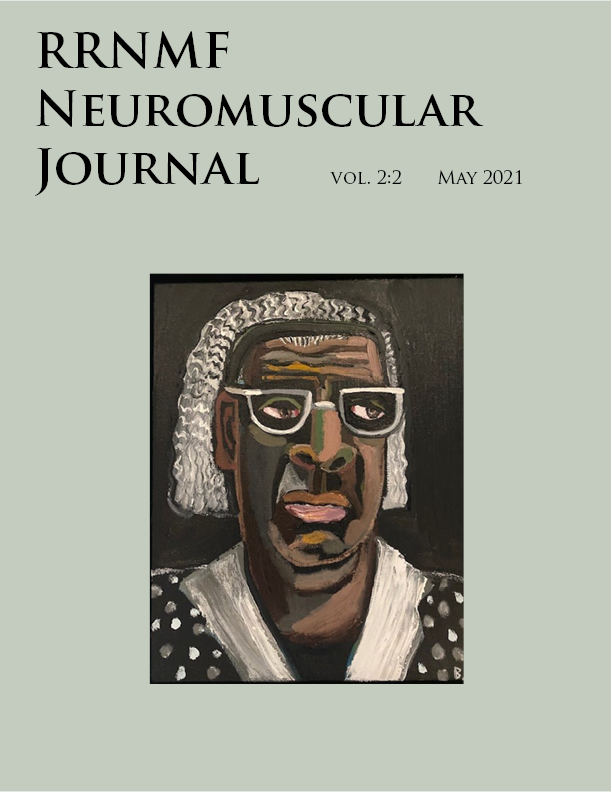Ketamine prolongs survival in symptomatic SOD1-G93A mice
DOI:
https://doi.org/10.17161/rrnmf.v2i2.15108Keywords:
Ketamine, survival, SOD1-G93A, neuroprotectionAbstract
Objective. Although riluzole and edaravone are FDA-approved for Amyotrophic Lateral Sclerosis (ALS), these drugs have negligible effect on disease progression and survival. Recent studies reporting neuroprotection from sub-anesthetic doses of ketamine support testing this drug in this rapidly progressing and fatal disease.
Methods. We administered ketamine at 0, 10, and 30 mg/kg to SOD1-G93A mice 5 days/week beginning at 90 days of age. We measured body weight, grip strength, and survival in this model of ALS.
Results. Although ketamine did not influence disease-related loss of body weight, it did delay grip strength declines in the 30 mg/kg group. Ketamine also prolonged survival in the 30 mg/kg group and dose-dependently increased the latency between 20% loss of body weight and death.
Conclusions. These results support further testing of ketamine in preclinical models of ALS to determine optimal dosing. They also support testing in the clinic given the limited efficacy of current ALS treatments and given FDA approval of ketamine for other indications like treatment-resistant depression.
Downloads
References
Robberecht W, Philips T. The changing scene of amyotrophic lateral sclerosis. Nat Rev Neurosci. 2013;14(4):248-264.
Song JH, Huang CS, Nagata K, Yeh JZ, Narahashi T. Differential action of riluzole on tetrodotoxin-sensitive and tetrodotoxin-resistant sodium channels. J Pharmacol Exp Ther. 1997;282(2):707-714.
Debono MW, Le Guern J, Canton T, Doble A, Pradier L. Inhibition by riluzole of electrophysiological responses mediated by rat kainate and NMDA receptors expressed in Xenopus oocytes. Eur J Pharmacol. 1993;235(2-3):283-289.
Azbill RD, Mu X, Springer JE. Riluzole increases high-affinity glutamate uptake in rat spinal cord synaptosomes. Brain Res. 2000;871(2):175-180.
Watanabe K, Tanaka M, Yuki S, Hirai M, Yamamoto Y. How is edaravone effective against acute ischemic stroke and amyotrophic lateral sclerosis? J Clin Biochem Nutr. 2018;62(1):20-38.
Miller RG, Mitchell JD, Moore DH. Riluzole for amyotrophic lateral sclerosis (ALS)/motor neuron disease (MND). Cochrane Database Syst Rev. 2012(3):CD001447.
Bell JD. In Vogue: Ketamine for Neuroprotection in Acute Neurologic Injury. Anesth Analg. 2017;124(4):1237-1243.
Moda-Sava RN, Murdock MH, Parekh PK, Fetcho RN, Huang BS, Huynh TN, Witztum J, Shaver DC, Rosenthal DL, Alway EJ, Lopez K, Meng Y, Nellissen L, Grosenick L, Milner TA, Deisseroth K, Bito H, Kasai H, Liston C. Sustained rescue of prefrontal circuit dysfunction by antidepressant-induced spine formation. Science. 2019;364(6436):eaat8078.
Wang R, Zhang Z, Kumar M, Xu G, Zhang M. Neuroprotective potential of ketamine prevents developing brain structure impairment and alteration of neurocognitive function induced via isoflurane through the PI3K/AKT/GSK-3β pathway. Drug Des Devel Ther. 2019;13:501-512.
Potter DE, Choudhury M. Ketamine: repurposing and redefining a multifaceted drug. Drug Discov Today. 2014;19(12):1848-1854.
Singh NS, Rutkowska E, Plazinska A, Khadeer M, Moaddel R, Jozwiak K, Bernier M, Wainer IW. Ketamine Metabolites Enantioselectively Decrease Intracellular D-Serine Concentrations in PC-12 Cells. PLoS One. 2016;11(4):e0149499.
Williams NR, Heifets BD, Blasey C, Sudheimer K, Pannu J, Pankow H, Hawkins J, Birnbaum J, Lyons DM, Rodriguez CI, Schatzberg AF. Attenuation of Antidepressant Effects of Ketamine by Opioid Receptor Antagonism. Am J Psychiatry. 2018;175(12):1205-1215.
Sleigh J, Harvey M, Voss L, Denny B. Ketamine – More mechanisms of action than just NMDA blockade. Trends Anaesth Crit Care. 2014;4(2-3):76-81.
Fava M, Freeman MP, Flynn M, Judge H, Hoeppner BB, Cusin C, Ionescu DF, Mathew SJ, Chang LC, Iosifescu DV, Murrough J, Debattista C, Schatzberg AF, Trivedi MH, Jha MK, Sanacora G, Wilkinson ST, Papakostas GI. Double-blind, placebo-controlled, dose-ranging trial of intravenous ketamine as adjunctive therapy in treatment-resistant depression (TRD). Mol Psychiatry. 2020;25(7):1592-1603.
Hayashi H, Dikkes P, Soriano SG. Repeated administration of ketamine may lead to neuronal degeneration in the developing rat brain. Paediatr Anaesth. 2002;12(9):770-774.
Slikker W Jr, Zou X, Hotchkiss CE, Divine RL, Sadovova N, Twaddle NC, Doerge DR, Scallet AC, Patterson TA, Hanig JP, Paule MG, Wang C. Ketamine-induced neuronal cell death in the perinatal rhesus monkey. Toxicol Sci. 2007;98(1):145-158.
Aleksandrova LR, Wang YT, Phillips AG. Ketamine and its metabolite, (2R,6R)-HNK, restore hippocampal LTP and long-term spatial memory in the Wistar-Kyoto rat model of depression. Mol Brain. 2020;13(1):92.
Li Y, Ding R, Ren X, Wen G, Dong Z, Yao H, Tan Y, Yu H, Wang X, Zhan X, Yao J, Lu Y, Zhang G, Wu X. Long-term ketamine administration causes Tau protein phosphorylation and Tau protein-dependent AMPA receptor reduction in the hippocampus of mice. Toxicol Lett. 2019;315:107-115.
Pieri M, Carunchio I, Curcio L, Mercuri NB, Zona C. Increased persistent sodium current determines cortical hyperexcitability in a genetic model of amyotrophic lateral sclerosis. Exp Neurol. 2009;215(2):368-379.
Saba L, Viscomi MT, Martini A, Caioli S, Mercuri NB, Guatteo E, Zona C. Modified age-dependent expression of NaV1.6 in an ALS model correlates with motor cortex excitability alterations. Neurobiol Dis. 2019;130:104532.
US Food and Drug Administration. FDA approves new nasal spray medication for treatment-resistant depression; available only at a certified doctor’s office or clinic. https://www.fda.gov/news-events/press-announcements/fda-approves-new-nasal-spray-medication-treatment-resistant-depression-available-only-certified. Accessed November 27, 2020
Downloads
Published
Issue
Section
License
Copyright (c) 2021 John A. Stanford, Matthew Macaluso, Richard J. Barohn, Lauren Peck

This work is licensed under a Creative Commons Attribution-NonCommercial-NoDerivatives 4.0 International License.

